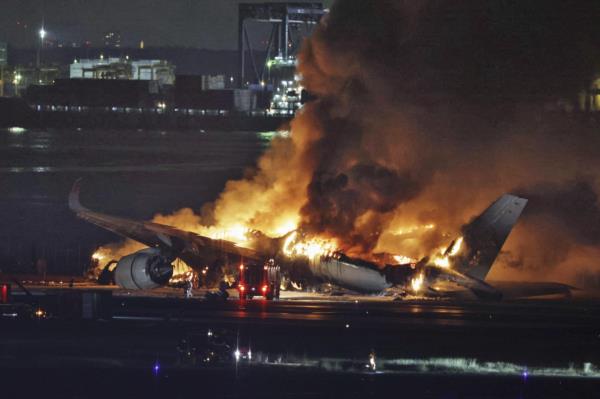
Tragedy at Tokyo's Haneda Airport as investigators uncover new clues about a deadly collision between a Japan Airlines passenger jet and a Japanese Coast Guard plane. According to recent reports, the pilots of the passenger jet claim they did not see the smaller aircraft on the runway before the collision occurred. Startlingly, records reveal that the runway warning lights meant to prevent such incidents had been out of service for several days leading up to the accident.
The collision resulted in the loss of five crew members aboard the Coast Guard plane, with one individual sustaining injuries. Publicly available records indicate that the red warning lights, which play a crucial role in guiding pilots and preventing them from mistakenly entering active runways, had been malfunctioning at Haneda Airport for seven days up until the day of the tragic accident.
Japanese authorities have now released a transcript covering over four minutes of communication between air traffic control and the two planes involved in the collision. Just moments before the incident unfolded, the control tower issued a command to the Coast Guard plane, instructing it to taxi to holding point C5. While this command typically implies that the aircraft should stop short of crossing another runway, experts have noted that it lacked the specificity normally provided in such communications.
According to the transcript, the crew of the Coast Guard plane acknowledged the command from the control tower, responding with a confirmation of their intentions to taxi to the specified holding point. However, it remains unclear why the aircraft was on the runway instead of adhering to the command to remain short of it.
As investigations continue, additional information has emerged regarding the response to the accident. Japan Airlines has reported that the in-flight announcement system on the affected passenger plane malfunctioned during the evacuation process. As a result, cabin crew members were forced to rely on handheld megaphones and their own voices to guide passengers off the burning aircraft. Remarkably, all onboard, comprising nearly 400 passengers, survived the harrowing incident.
Passengers aboard the Japan Airlines flight have recounted their experiences, expressing gratitude for the swift evacuation process. Adhering to instructions and leaving personal belongings behind proved crucial in ensuring everyone's safety. Safety experts have commended the passengers' cooperation and highlighted the effectiveness of the evacuation, dispelling previous skepticism regarding the feasibility of evacuating large groups in a timely manner.
Additionally, experts have noted that aircraft design played a significant role in minimizing casualties. Modern aircraft such as Airbus planes incorporate less toxic and less flammable materials within the cabin, reducing the risk of fire. The actual structure of these aircraft also boasts increased fire resistance, another factor credited with ensuring a higher survival rate among passengers.
As investigations progress, authorities will delve further into the circumstances that led to this devastating collision. With more information coming to light, the hope is that comprehensive safety measures can be established to prevent similar incidents from occurring in the future.







